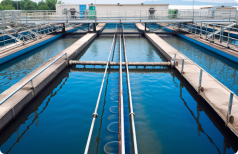Food wastewater treatment

The food industry has a wide range of raw materials and a wide variety of products, with significant differences in the amount and quality of wastewater discharged. Therefore, the wastewater generated during the production process needs to undergo a series of treatments to ensure that it does not damage the natural environment.
Equipment Process
Food industry wastewater itself is non-toxic, but contains a large amount of degradable organic matter. If the wastewater is not treated and discharged into the water, it will consume a large amount of dissolved oxygen, causing oxygen deficiency in the water and causing the death of fish and aquatic organisms. The suspended solids in wastewater sink to the bottom of the river and decompose under anaerobic conditions, producing odors that worsen water quality and pollute the environment. If wastewater is introduced into farmland for irrigation, it will affect the consumption of agricultural fruits and pollute groundwater sources. The animal excrement carried in wastewater contains insect eggs and pathogenic bacteria, which can lead to the spread of diseases and directly endanger human and animal health. Therefore, various harmful components must be removed from food industry wastewater before discharge.
Equipment Advantages
-

Simple management and stable results|The treatment system adopts a form that has been proven to be effective, with obvious technical and economic benefits, strong adaptability, simple management, and stable results through engineering practice, fully ensuring that the treated effluent meets the discharge standards
-

Low energy consumption and high efficiency|Sewage and sludge treatment equipment selects products with new materials, low energy consumption, high efficiency, easy maintenance, and good cost-effectiveness
-

Reliable operation and convenient maintenance|Control management should consider self-control as much as possible according to the requirements of the treatment process, reduce the labor intensity of operation, make the operation of the sewage treatment station reliable and easy to maintain, and improve the operation and management level of the sewage treatment station
-

Reasonable land occupation|When designing the plane layout and engineering, we should combine the existing site to strive for a compact, concise, neat, and aesthetically pleasing layout
-

Less consumption and investment|Low consumption and investment. By adopting advanced and mature A/O biochemical treatment processes, the removal rate of pollutants is improved, which has the characteristics of low power consumption and low investment to ensure that the effluent meets the discharge standards
-

Good effect|By selecting reasonable design parameters such as surface load, effective water depth, and mud bucket inclination angle of the secondary sedimentation tank, the solid-liquid separation effect can be improved
设备参数
Application Area
-

Sugar industry
-

Poultry and egg processing industry
-

Aquatic product processing industry
-

Meat and Meat Products Industry
-

Grain processing industry
CONTACT US

Official Account


Mobile Browsing






 Hotline:
Hotline: Address:No.76 Longfei Road, Chengyang District,Qingdao, Shandong Province, China
Address:No.76 Longfei Road, Chengyang District,Qingdao, Shandong Province, China E-mail:y15092162376@163.com
E-mail:y15092162376@163.com